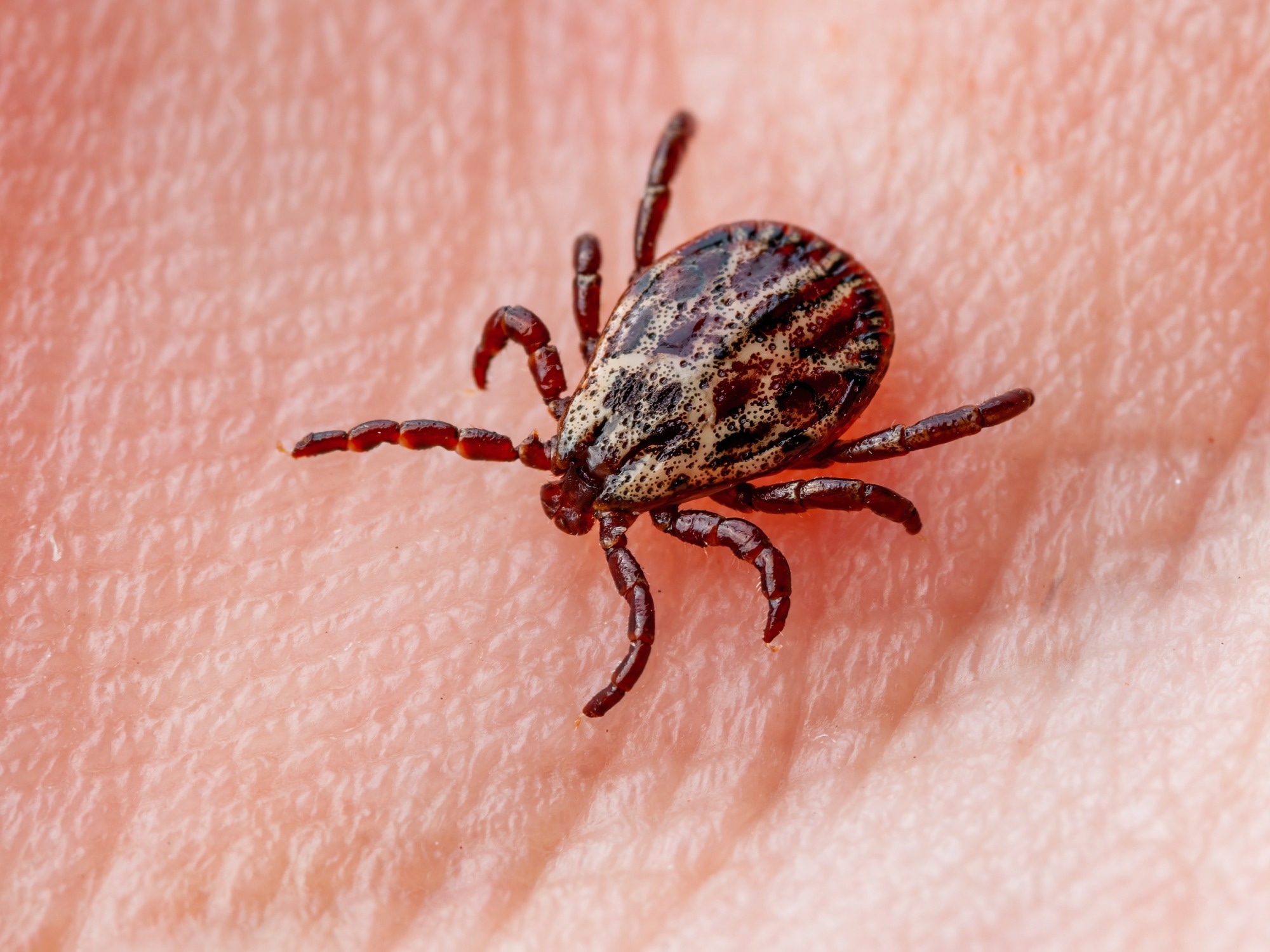 Study: Tick-Borne Disease Infections and Chronic Musculoskeletal Pain. Image Credit: nechaevkon/Shutterstock.com
Study: Tick-Borne Disease Infections and Chronic Musculoskeletal Pain. Image Credit: nechaevkon/Shutterstock.com
Background
Their cross-sectional evaluation of 488 individuals revealed that 9% and 20% of the sample cohort had been exposed to TDBs. Still, no associations could be found between Rickettsia, Ehrlichia, and musculoskeletal symptoms.
In contrast, individuals with a seroprevalence-confirmed history of α-gal reported higher rates of knee-related discomfort, highlighting the need for future investigations into the disease.
The menace of ticks
Ticks are external parasites belonging to the superorder Parasitiformes. These arachnids are approximately 3-5 mm long and live by feeding on the blood of mammals, birds, and rarely reptiles and amphibians.
While rarely harmful, ticks play host to a wide range of pathogens, including ehrlichiosis, tularemia, and, most notably, Lyme disease.
Alarmingly, the incidence of tick-borne diseases (TBDs) is rapidly increasing, with more than 50,000 cases reported in the United States (US) in 2019 alone, more than double the number from 2000.
Research suggests that even this number is an underestimation, given that many TBDs remain asymptomatic.
Historically, studies have focused on anti-Lyme disease interventions, leaving most other TBDs understudied. However, in some southeastern states, rickettsiosis and ehrlichiosis are higher than that of Lyme disease, making them crucial public health issues.
“Rocky Mountain spotted fever (RMSF), caused by infection with Rickettsia rickettsii, is historically considered to have the highest fatality rate, but more than half of ehrlichiosis cases require hospitalization, with case fatality rates that can exceed 10% in immunocompromised populations. Severe RMSF can have long-term neurological sequelae believed to be associated with vascular damage in the central nervous system.”
Encouragingly, most TBDs, including rickettsiosis and ehrlichiosis, are easily treatable if infections are diagnosed early on. However, a growing body of anecdotal evidence suggests that some TBDs might present persistent symptoms months or even years following initial infection recovery.
Most of these reported symptoms are musculoskeletal, but studies investigating the medical validity of these claims remain lacking.
About the study
In the present study, researchers used serum antibody evaluations to investigate the prevalence of Rickettsia, Ehrlichia, and Galactose-α-1,3-galactose (α-gal) in Johnston County citizens. Their cross-sectional study consisted of a sample cohort derived from the Johnston County Osteoarthritis (JoCo OA) project, an ongoing longitudinal cohort comprising Johnston County residents aged 45 and older.
Data collection included blood (serum) samples, physical examinations, performance-based assessments, and self-reported demographic information.
Indirect immunofluorescence assays were used to screen serum samples for immunoglobulin G (IgG) antibodies specific to the diseases of interest. ImmunoCAP assays were used to screen for immunoglobulin E (IgE) antibodies.
The Knee Injury and Osteoarthritis Outcome Score (KOOS) was used to evaluate participant musculoskeletal response based on pain, aching, or stiffness (PAS), physical function, and overall quality of life.
Radiographic knee osteoarthritis (RKOA) evaluations were carried out using the Kellgren-Lawrence grade with radiographic imaging.
Study findings
Of the 605 initial study participants, 488 provided sufficient serum samples and were included in the analyses. Demographic characteristics included a median age of 72, 69% female (n = 336), and 67% White (327) individuals.
IgG analysis revealed that 77 and 45 participants, respectively, had suffered from rickettsiosis and ehrlichiosis.
Surprisingly, despite 36.5% of participants presenting serum antibodies specific to TBDs, only 17.2% recalled being bitten by fleas during the preceding five years. This suggests that ticks remain underestimated within the region despite a high prevalence of tick bites in Johnston County.
IgE analyses depict that 197 participants had exposure to α-gal infections, with 94 presenting clinically relevant α-gal (IgE > 0.1IU/mL).
“No associations were observed between antibodies to Ehrlichia, SFGR, and α-gal IgE level greater than 0.1 IU/mL and baseline comorbidities, including age-adjusted Charlson Comorbidity Index”
Musculoskeletal evaluations could not reveal associations between TBD infections and persistent musculoskeletal symptoms.
However, patients with serum confirmed α-gal infections, especially those with clinically relevant α-gal were found to report much higher KOOS and RKOA scores than their α-gal-free counterparts, suggesting the need for future research into the specific relationship between α-gal and osteo-related symptoms.
Conclusions
The present study identified a 36.5% prevalence of TBDs in a 488-strong cohort of Johnson County residents. Surprisingly, despite this high prevalence rate, only 17.2% of the cohort recalled tick bites in the five years preceding the study.
While the study could not establish the relationship between TBDs and chronic musculoskeletal symptoms, the strong association between α-gal-positive IgE evaluation and higher knee-related discomfort reports suggests the need for future research into their relationships.